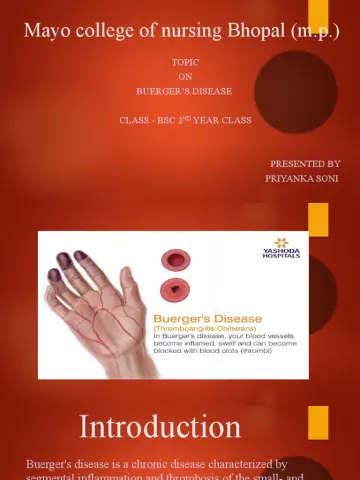- Author Rachel Wainwright [email protected].
- Public 2023-12-15 07:39.
- Last modified 2025-11-02 20:14.
Botkin's disease
The content of the article:
- Causes and risk factors
- Forms of the disease
- Disease stages
- Symptoms of Botkin's disease
- Diagnostics
- Treatment
- Possible complications and consequences
- Forecast
- Prevention
Botkin's disease (viral hepatitis A) is an infectious liver disease, which is one of the most favorable forms of hepatitis, since it is not prone to becoming chronic. Botkin's disease is one of the most common intestinal infections. The disease affects all categories of the population, more often hepatitis A is diagnosed in children, but in recent years there has been an increase in the incidence in adults.

Source: yandex.net
The prevalence of this form of hepatitis is directly related to poor sanitary conditions and hot climate, so this indicator is especially high in developing countries.
Causes and risk factors
Hepatitis A virus belongs to the RNA-containing viruses of the Hepatovirus genus. It is quite stable in the environment: at a temperature of 4 ° C it lasts for several months, at -20 ° C it lasts for years, at room temperature for several weeks. Withstands boiling for up to 5 minutes; when exposed to ultraviolet radiation, inactivation occurs within a minute; able to remain viable for some time in chlorinated tap water. It has an acid-resistant membrane, which allows it to pass through the acidic gastric environment without damage. The hepatitis A virus is characterized by high immunogenicity; after a previous illness, a persistent lifelong immunity is formed in a person.

Source: mpilot.ru
The source of infection is a sick person. Infection occurs mainly through contact-household (through dishes, other household items) and alimentary (when eating contaminated products). When hepatitis A virus enters public water reservoirs, outbreaks occur. Less common is the parenteral route of transmission - through the blood in case of violation of the rules for intravenous injections, blood transfusion, dental procedures.
The spread of Botkin's disease most often occurs in children's groups. At risk are employees of the catering sector, medical and sanatorium institutions, people leading an asocial lifestyle.
Most often, Botkin's disease affects children 3-12 years old and young people. The incidence is seasonal, its increase is noted in the summer-autumn period.
Forms of the disease
Botkin's disease can have a typical (with the presence of symptoms characteristic of hepatitis) and atypical (no specific symptoms) course.
Depending on the clinical picture, the following forms of the disease are distinguished:
- icteric;
- anicteric;
- erased;
- subclinical.
According to the duration of the course, Botkin's disease can be acute or protracted. Depending on the severity: mild, moderate and severe.
The prodromal period of Botkin's disease can occur in a febrile, dyspeptic, asthenovegetative and mixed form.
Disease stages
In the clinical course of a typical variant of Botkin's disease, three stages are distinguished:
- Prodromal (pre-jaundice) period.
- Icteric period.
- Reconvalescence.
Symptoms of Botkin's disease
In some cases (more often in children under 6 years of age), the disease is asymptomatic.
The incubation period for Botkin's disease is 3-4 weeks. The onset is usually acute.
The febrile variant of the prodromal period of Botkin's disease is characterized by an increase in temperature to high numbers, accompanied by pronounced signs of intoxication of the body (weakness, headache, pain in joints and muscles, decreased appetite), nausea, belching, discomfort in the stomach and liver, as well as symptoms of catarrhal inflammation of the upper respiratory tract - sore throat, rhinitis, dry cough.
In the dyspeptic variant of the prodromal period of the disease, catarrhal symptoms are usually absent. Patients complain of nausea, vomiting, belching, bitterness in the mouth, dull pain in the right hypochondrium and epigastric region, as well as upset stools (diarrhea or constipation, or their alternation).
The asthenovegetative variant of the pre-icterus period is not very specific. There is general weakness, lethargy, increased fatigue, decreased performance, sleep disturbances, and decreased appetite. In some cases, the disease can begin with the development of jaundice in the absence of any signs of the prodromal period.
The mixed variant of the prodromal period is characterized by a combination of several clinical syndromes.
The prodromal period usually lasts from two to ten days, gradually turning into the icteric stage. Signs of general intoxication disappear, body temperature normalizes, the patient's general condition improves. However, dyspeptic symptoms, as a rule, not only persist, but also become more pronounced. Other symptoms of Botkin's disease in the icteric period include darkening of urine, icterus of the sclera, the mucous membranes of the soft palate and the frenulum of the tongue turn yellow, and then the skin. A yellowish coating is found on the tongue and teeth. The feces lighten up to complete discoloration.

Source: twofb.ru
With a severe course of Botkin's disease, hemorrhagic syndrome develops (hemorrhages, petechiae on the skin and mucous membranes, nosebleeds, etc. appear). The liver is enlarged, painful on palpation, in 10-20% of cases the spleen is enlarged. Bradycardia and hypotension are observed, asthenic-vegetative symptoms, disorders of the central nervous system can develop.
The duration of the icteric period ranges from several weeks to a month, after which convalescence begins, i.e., recovery. There is a regression of intoxication, jaundice, the size of the liver is normalized. This stage can last 3-6 months.
Botkin's disease is usually mild to moderate. The transition of the disease to a chronic form or virus carrier (latent form) does not occur.
Diagnostics
To make a diagnosis, a collection of complaints and anamnesis, physical examination, laboratory tests of blood and urine are carried out. In order to determine the morphological and functional state of the liver, they resort to the methods of instrumental diagnostics.
In the general analysis of blood, a decrease in the number of leukocytes, lymphocytosis, and an increase in ESR are found. In the course of a biochemical blood test, a sharp (8-10 times) increase in the activity of hepatic transaminases, an increase in the concentration of bilirubin (mainly due to direct bilirubin), and a decrease in the level of albumin are revealed. The prothrombin index is usually below normal.
The specific diagnosis of Botkin's disease, that is, the identification of the pathogen, is carried out using enzyme immunoassays and radioimmunoassays. In the icteric period, there is an increase in the IgM titer, at the stage of convalescence - IgG. In addition, the detection of RNA of the hepatitis A virus is carried out by the method of polymerase chain reaction.
Treatment
Treatment of Botkin's disease in most cases is carried out on an outpatient basis. Hospitalization is required only for severe forms of the disease, for epidemiological indications. In the presence of pronounced signs of general intoxication, bed rest is indicated. An important component of therapy is adherence to a diet (table No. 5 according to Pevzner) and a drinking regimen (abundant drink).
Etiotropic therapy for hepatitis A has not been developed; treatment is aimed at reducing symptoms and pathogenetic correction. To reduce signs of severe intoxication, intravenous infusion of crystalloid solutions is performed. In order to normalize the digestive processes, lactulose preparations are used. To prevent the development of cholestasis, antispasmodics are prescribed. In some cases, it becomes necessary to use corticosteroid drugs. With the development of hemorrhagic syndrome, it may be necessary to use hemostatic drugs that are poured into the stomach with a probe. In the case of a bacterial infection, antibacterial drugs are used.
After the disappearance of the clinical manifestations of the disease, dispensary observation by a gastroenterologist is indicated for 3-6 months.
Possible complications and consequences
In rare cases, against the background of Botkin's disease, cholangitis, dyskinesia of the biliary tract and gallbladder, cholecystitis can develop. Severe complications from the liver (acute hepatic encephalopathy), severe internal hemorrhages, cirrhosis, liver cancer, coma, and death are extremely rare.
Forecast
With timely and correctly selected treatment, the prognosis is favorable. Complete restoration of liver function occurs in about 90% of cases, the remaining patients have residual effects. Mortality in Botkin's disease is no more than 0.04%.
Prevention
General preventive measures aimed at preventing the development of Botkin's disease include control over wastewater discharge, ensuring high-quality purification of drinking water, providing the population with food in accordance with sanitary and hygienic requirements, ensuring the necessary quarantine measures in case of outbreaks of Botkin's disease in organized children and adults. collectives. Contact persons are subject to observation for a month from the moment of contact with the patient. In the foci of infection, it is necessary to carry out disinfection measures.
Vaccination against hepatitis A is recommended for children starting from the second year of life, as well as for adults who have no history of Botkin's disease and who, at the same time, have an increased risk of infection (medical workers of infectious diseases departments, workers of water supply and public catering enterprises, persons traveling to zones, epidemically dangerous for viral hepatitis A, personnel of preschool institutions, social workers in contact with injection drug users, etc.).
In order to reduce the risk of infection with the hepatitis A virus, it is recommended to follow the rules of personal hygiene, do not eat food of dubious quality, avoid drinking water from questionable sources and open water bodies, and avoid contact with patients with Botkin's disease.
YouTube video related to the article:

Anna Aksenova Medical journalist About the author
Education: 2004-2007 "First Kiev Medical College" specialty "Laboratory Diagnostics".
The information is generalized and provided for informational purposes only. At the first sign of illness, see your doctor. Self-medication is hazardous to health!






